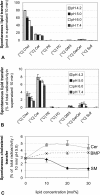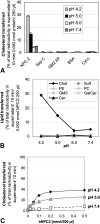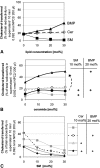Role of endosomal membrane lipids and NPC2 in cholesterol transfer and membrane fusion
- PMID: 20179319
- PMCID: PMC2882726
- DOI: 10.1194/jlr.M003822
Role of endosomal membrane lipids and NPC2 in cholesterol transfer and membrane fusion
Abstract
We examined the effect of Niemann-Pick disease type 2 (NPC2) protein and some late endosomal lipids [sphingomyelin, ceramide and bis(monoacylglycero)phosphate (BMP)] on cholesterol transfer and membrane fusion. Of all lipid-binding proteins tested, only NPC2 transferred cholesterol at a substantial rate, with no transfer of ceramide, GM3, galactosylceramide, sulfatide, phosphatidylethanolamine, or phosphatidylserine. Cholesterol transfer was greatly stimulated by BMP, little by ceramide, and strongly inhibited by sphingomyelin. Cholesterol and ceramide were also significantly transferred in the absence of protein. This spontaneous transfer of cholesterol was greatly enhanced by ceramide, slightly by BMP, and strongly inhibited by sphingomyelin. In our transfer assay, biotinylated donor liposomes were separated from fluorescent acceptor liposomes by streptavidin-coated magnetic beads. Thus, the loss of fluorescence indicated membrane fusion. Ceramide induced spontaneous fusion of lipid vesicles even at very low concentrations, while BMP and sphingomyelin did so at about 20 mol% and 10 mol% concentrations, respectively. In addition to transfer of cholesterol, NPC2 induced membrane fusion, although less than saposin-C. In this process, BMP and ceramide had a strong and mild stimulating effect, and sphingomyelin an inhibiting effect, respectively. Note that the effects of the lipids on cholesterol transfer mediated by NPC2 were similar to their effect on membrane fusion induced by NPC2 and saposin-C.
Figures









Similar articles
-
Acid sphingomyelinase activity is regulated by membrane lipids and facilitates cholesterol transfer by NPC2.J Lipid Res. 2014 Dec;55(12):2606-19. doi: 10.1194/jlr.M054528. Epub 2014 Oct 22. J Lipid Res. 2014. PMID: 25339683 Free PMC article.
-
Development of an assay for the intermembrane transfer of cholesterol by Niemann-Pick C2 protein.Biol Chem. 2007 Jun;388(6):617-26. doi: 10.1515/BC.2007.063. Biol Chem. 2007. PMID: 17552909
-
Concerted regulation of npc2 binding to endosomal/lysosomal membranes by bis(monoacylglycero)phosphate and sphingomyelin.PLoS Comput Biol. 2017 Oct 30;13(10):e1005831. doi: 10.1371/journal.pcbi.1005831. eCollection 2017 Oct. PLoS Comput Biol. 2017. PMID: 29084218 Free PMC article.
-
Lysosomal degradation of membrane lipids.FEBS Lett. 2010 May 3;584(9):1700-12. doi: 10.1016/j.febslet.2009.10.021. Epub 2009 Oct 16. FEBS Lett. 2010. PMID: 19836391 Review.
-
Biological function of the cellular lipid BMP-BMP as a key activator for cholesterol sorting and membrane digestion.Neurochem Res. 2011 Sep;36(9):1594-600. doi: 10.1007/s11064-010-0337-6. Epub 2010 Dec 7. Neurochem Res. 2011. PMID: 21136156 Review.
Cited by
-
Membrane-spanning lipids for an uncompromised monitoring of membrane fusion and intermembrane lipid transfer.J Lipid Res. 2015 Oct;56(10):1861-79. doi: 10.1194/jlr.M056929. Epub 2015 Aug 11. J Lipid Res. 2015. PMID: 26269359 Free PMC article.
-
Loss of Niemann-Pick C1 or C2 protein results in similar biochemical changes suggesting that these proteins function in a common lysosomal pathway.PLoS One. 2011;6(8):e23677. doi: 10.1371/journal.pone.0023677. Epub 2011 Aug 24. PLoS One. 2011. PMID: 21887293 Free PMC article.
-
Activation mobilizes the cholesterol in the late endosomes-lysosomes of Niemann Pick type C cells.PLoS One. 2012;7(1):e30051. doi: 10.1371/journal.pone.0030051. Epub 2012 Jan 20. PLoS One. 2012. PMID: 22276143 Free PMC article.
-
Mannose 6 dephosphorylation of lysosomal proteins mediated by acid phosphatases Acp2 and Acp5.Mol Cell Biol. 2012 Feb;32(4):774-82. doi: 10.1128/MCB.06195-11. Epub 2011 Dec 12. Mol Cell Biol. 2012. PMID: 22158965 Free PMC article.
-
My journey into the world of sphingolipids and sphingolipidoses.Proc Jpn Acad Ser B Phys Biol Sci. 2012;88(10):554-82. doi: 10.2183/pjab.88.554. Proc Jpn Acad Ser B Phys Biol Sci. 2012. PMID: 23229750 Free PMC article. Review.
References
-
- Brown M. S., Goldstein J. L. 1986. A receptor-mediated pathway for cholesterol homeostasis. Science. 232: 34–47. - PubMed
-
- Ikonen E. 2008. Cellular cholesterol trafficking and compartmentalization. Nat. Rev. Mol. Cell Biol. 9: 125–138. - PubMed
-
- Möbius W., van Donselaar E., Ohno-Iwashita Y., Shimada Y., Heijnen H. F., Slot J. W., Geuze H. J. 2003. Recycling compartments and the internal vesicles of multivesicular bodies harbor most of the cholesterol found in the endocytic pathway. Traffic. 4: 222–231. - PubMed
-
- Pentchev P. G., Comly M. E., Kruth H. S., Tokoro T., Butler J., Sokol J., Filling-Katz M., Quirk J. M., Marshall D. C., Patel S., et al. 1987. Group C Niemann-Pick disease: faulty regulation of low-density lipoprotein uptake and cholesterol storage in cultured fibroblasts. FASEB J. 1: 40–45. - PubMed
Publication types
MeSH terms
Substances
LinkOut - more resources
Full Text Sources
Medical
Molecular Biology Databases
Miscellaneous

